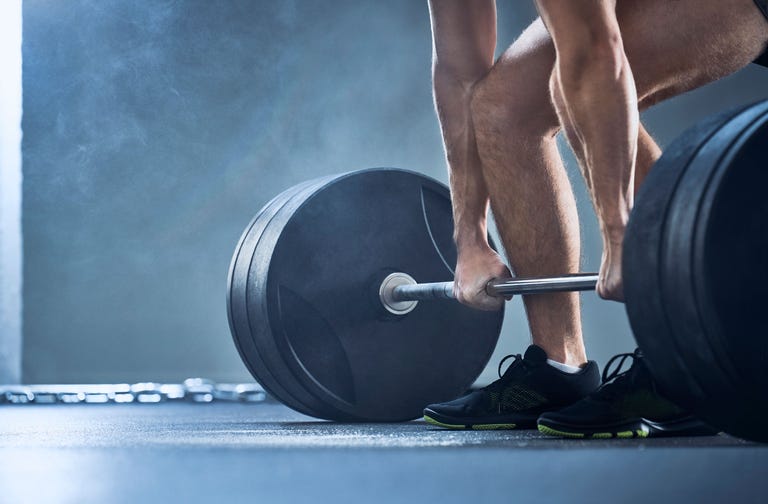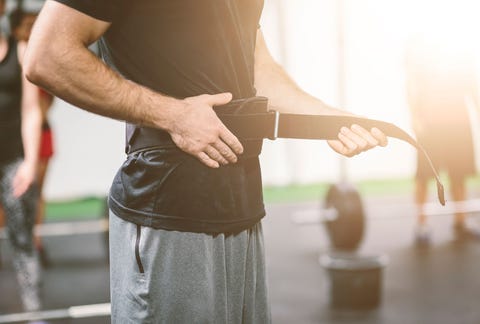
If your routine involves weightlifting or Olympic lifting, you’ve likely worn (or thought about wearing) a lifting belt in an effort to help prevent back pain. But is a belt really the ticket to relief? And do you actually know how to wear one? Here, fitness pros break down what to know before strapping one on—plus how to properly address back pain, too.
The Benefits of Lifting Belts
Most people who put on a lifting belt do so because they think it’ll help protect them from injury. But Joe Gambino, C.S.C.S., D.P.T., a New York-based physical therapist, says you definitely don’t need it for every single lift. “It is a pet peeve of mine watching people wear belts for every little thing they do in the gym,” he says.
That said, a weightlifting belt does serve a purpose in the gym. For one, weightlifting belts can increase intra-abdominal pressure to help stabilize your spine when you’re lifting heavy loads, Gambino says. Deadlifts and squats are two movements where a belt can help. What’s considered heavy? Anything greater than 85 percent of your one-rep max.
“Stability is key to the health of the lumbar spine, as it protects discs, supports muscles and joints, and limits injury,” adds physical therapist Scott Weiss, C.S.C.S., D.P.T.
“Weightlifting belts can increase intra-abdominal pressure to help stabilize your spine when lifting heavy loads”
What to Know Before Using a Belt
Determined to strap on one? First, you have to learn how to breathe to create intra-abdominal pressure, says Gambino. If you can’t create intra-abdominal pressure, you’ll have a hard time stabilizing your spine, which could lead to back pain. Gambino suggests doing a breathing drill (like this one) pre-workout.
Next, make sure the belt fits well and sits right. “Your belt should be tight enough that you can’t stick your hand between the belt and your skin, yet you should be able to expand your torso when taking a deep breath in,” Gambino says. Position the belt an inch or two above your pelvis so it covers as much of your abdominal and spinal erector muscles as possible. “This positioning also allows you to feel your torso expand into the belt when your inhale.”
Doing everything right and still noticing lingering back pain? Troubleshooting options, right this way.

Getty Images
● Make sure your technique is spot on with lighter weights before you start trying to go heavy. “An athletic trainer, personal trainer, exercise physiologist, vetted YouTube channel, or licensed P.T. can help with this in a jiffy,” Weiss says. And of course, always start with a lower weight and go slow.
● Consider magnesium. Mike Roussell, Ph.D., Men’s Health’s nutrition advisor, notes that 300 to 400 mg a day (preferably in the form of chelated magnesium, which is better absorbed by the body) has been shown to help with back pain. One study linked supplementation with a 49 percent reduction in low back pain symptoms. “Magnesium is needed as a co-factor for proper muscular contractions,” he says. “Insufficient magnesium levels can prevent proper functioning of your muscle cells, which can present as pain.”
“Our spines have multiple vertebrae for a reason—to help disperse force along the spine”
● Be careful when you bend over. “Most injuries to the lower back happen with flexion and rotation of the lumbar spine,” Weiss notes. Bending forward can compress the low back, damaging the area and leading to pain. That’s why he often urges clients to stay away from exercises like the Good Morning: “I see five to twenty injuries a year from this exercise.”
● Work that back. “Our spines have multiple vertebrae for a reason—to help disperse force along the spine,” Gambino says. “Due to the sedentary postures in which we sit, we often don’t take our spine through its normal range of motion.” The end result: Your stiff body can lose its ability to spread force along the spine. This can result in the body losing its ability to fully disperse force. Segmented Cat/Camels get your spine moving better and help create better joint health.
● Maintain full-body mobility. An area of the body that isn’t working right can cause pain in the joints above or below the dysfunction, Gambino notes. “If an area like the thoracic spine that is supposed to be mobile becomes stiff, it will force the movement to happen elsewhere—usually the segments above or below,” he says. Try Open Books to improve your mobility.
In the same vein, Gambino notes that if we lose hip mobility, we may have low back pain as a result. “One way to ensure hip health is to work on the joint capsule,” he says. Hip 90/90 PAILs/RAILs is one of his favorite drills for doing just that.
Source: Read Full Article
